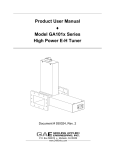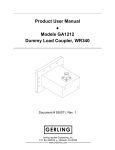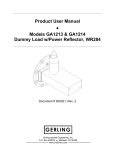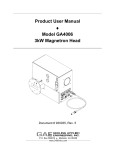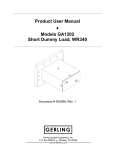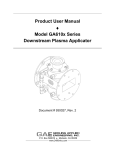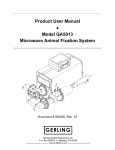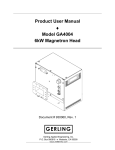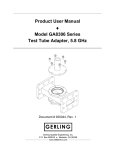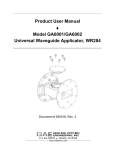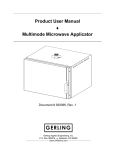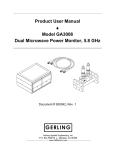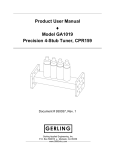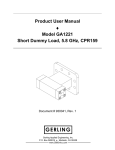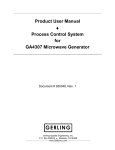Download Product User Manual
Transcript
Product User Manual ♦ Models GA1210 & GA1211 Dummy Load Coupler, WR284 Document # 930008, Rev. 1 GERLING Gerling Applied Engineering, Inc. P.O. Box 580816 ♦ Modesto, CA 95358 www.2450mhz.com Product User Manual Models GA1210 & GA1211 – Dummy Load Coupler, WR284 REV. 1 REVISION HISTORY DESCRIPTION RELEASE Page 2 930008, Rev. 1 DATE 11JUL03 APPROVAL JFG WARRANTY Products manufactured and sold by Gerling Applied Engineering, Inc. (“GAE”) are warranted to be free of defects in materials and workmanship under normal use and service for a period of twelve (12) months from the date of original shipment. GAE’s obligation under this warranty is limited to repairing or replacing, at GAE’s option, all non-consumable component parts. Consumable parts are specifically excluded from this warranty and may include, but are not be limited to, magnetrons, fuses, lamps, seals, o-rings, v-belts, and fluids. All warranty repairs are to be done at GAE’s facility or as otherwise authorized by GAE. All shipping charges for warranty repair or replacement are the purchaser’s responsibility unless otherwise agreed to by GAE. This warranty supercedes all other warranties, expressed or implied. No warranty is given covering the product for any particular purpose other than as covered by the applicable product specifications. GAE assumes no liability in any event for incidental or consequential damages, financial losses, penalties or other losses incurred in conjunction with the use of GAE products. DOCUMENT CONVENTIONS NOTE: Means the reader should take note. Notes contain helpful information, suggestions, or references to other sections, chapters, or documents. CAUTION: Means the reader should be careful. You are doing something that might result in equipment damage or loss of data. WARNING: Means danger. A situation exists that could cause bodily injury or death. All personnel must be aware of the hazards involved with high voltage electrical circuitry and high power microwave devices. © 2003 Gerling Applied Engineering, Inc. Modesto, CA Product User Manual Models GA1210 & GA1211 – Dummy Load Coupler, WR284 Page 3 930008, Rev. 1 WARNING All waveguide dummy loads manufactured by GAE are intended for use with other equipment capable of producing a microwave field that is potentially hazardous to operating personnel. It must never be connected or operated in a manner that allows a field in excess of 10 milliwatts per square centimeter to be generated in an area accessible to operating personnel. Contact GAE, Inc. for technical support prior to installation and/or operation of this unit if there is any question or concern about microwave leakage. All waveguide flange and electrical cable connections throughout the system must be secure prior to operation. Never operate the microwave generator without a properly rated absorbing load attached. To ensure safe operation and prevent microwave leakage, the equipment must be periodically inspected and maintained as required or recommended. © 2003 Gerling Applied Engineering, Inc. Modesto, CA Product User Manual Models GA1210 & GA1211 – Dummy Load Coupler, WR284 Page 4 930008, Rev. 1 TABLE OF CONTENTS EQUIPMENT DESCRIPTION ......................................................................................... 5 Specifications 5 INSTALLATION .............................................................................................................. 7 Preliminary Inspection Waveguide Configuration Flange Connections Flange Alignment Pins Coupler Port Connection Water Flow Requirements Water Fitting Connections Storage and Shipping 7 7 8 8 8 8 9 9 THEORY OF OPERATION ........................................................................................... 10 Basic Operation Performance Considerations 10 10 USER MAINTENANCE AND REPAIR.......................................................................... 12 Insert Block Replacement Procedure © 2003 Gerling Applied Engineering, Inc. 12 Modesto, CA Product User Manual Models GA1210 & GA1211 – Dummy Load Coupler, WR284 Page 5 930008, Rev. 1 EQUIPMENT DESCRIPTION The models GA1210 and GA1211 Dummy Load Couplers are designed for dual purpose use in high power microwave networks. Primarily they are a means to dissipate up to 3kW of microwave power that is not being utilized for other purposes. Additionally, these loads provide a convenient means to measure the level of incident microwave power using common microwave power meters. The compact design and high reliability of these loads make them ideal for a variety of uses. Typical applications include magnetron isolation from reflected power (when used with a 3-port circulator), high power test stations and variable Q applicators. Microwave power delivered to the dummy load is absorbed by water which internally flows through channels in a solid UHMW polyethylene block. Naval brass is used for all water fitting connections to minimize corrosion. The waveguide body is fabricated with dip brazed aluminum. A non-directional coupling probe senses the internal electric field strength and delivers the signal through a Type N female connector. The waveguide flange on the GA1211 is designed to be used with the GA8401 Quick-Release clamp when connected to another similarly designed flange. It can also be connected to any other standard WR284 round flange (UG-584/U) using suitable fastener hardware. Specifications Waveguide WR284 Flange GA1210: UG1725/U GA1211: UG-584/U (round) with taper for quick-release clamp Frequency 2450 MHz nominal Incident Power Up to 3kW continuous Return Loss -25 dB min @ 2450 MHz, 75-85 °F inlet water Coupler Port Type N Female, 50 Ohm Coupling Factor 60 dB +/- 0.1 dB nominal @ 2450 MHz, 7585 °F inlet water Water Connections 1/8 NPT female Water Flow 1.0 gpm nominal, 2.0 gpm maximum © 2003 Gerling Applied Engineering, Inc. Modesto, CA Product User Manual Models GA1210 & GA1211 – Dummy Load Coupler, WR284 Page 6 930008, Rev. 1 Water Pressure 70 psi maximum Water Temp Inlet: 40 °F (4 °C) minimum Outlet: 150 °F (66 °C) maximum Overall Length 4.38 inches (11.1 cm) Net Weight 1.5 lb. (3.3 kgm) © 2003 Gerling Applied Engineering, Inc. Modesto, CA Product User Manual Models GA1210 & GA1211 – Dummy Load Coupler, WR284 Page 7 930008, Rev. 1 INSTALLATION Preliminary Inspection Upon arrival at the installation site the dummy load should be thoroughly inspected for damage or wear caused during shipping. Any visible damage to the packaging material or dummy load coupler should be noted and reported immediately to the shipping company in accordance with standard claims procedures. The following components are included: a) Dummy Load Coupler b) Product User Manual Waveguide Configuration The dummy load coupler can be connected to and used with any common waveguide component having a compatible flange. The mounting position can be in any orientation. Figure 1 below illustrates a common dual purpose configuration in which the dummy load coupler is used to both absorb and measure microwave power reflected from the process load. This configuration eliminates the need for a separate waveguide directional coupler. Figure 1 – Typical waveguide configuration using dummy load coupler to absorb and measure reflected microwave power. © 2003 Gerling Applied Engineering, Inc. Modesto, CA Product User Manual Models GA1210 & GA1211 – Dummy Load Coupler, WR284 Page 8 930008, Rev. 1 Flange Connections The waveguide flange of the dummy load coupler must be properly connected to another waveguide component having a similar flange style. Model GA1211 is designed to be used with the GA8401 Quick-Release flange clamp when connected to another similarly designed flange. It can also be connected to any other standard WR284 round flange (UG-584/U) using suitable fastener hardware. Flange Alignment Pins Each flange connection that uses a quick-release clamp requires two alignment pins for proper alignment of the adjacent waveguide sections. All GAE waveguide components include one alignment pin for each flange designed for use with quick-release clamps. Alignment pins can be installed into either of two threaded holes centered above and below the waveguide broadwalls. For obvious reasons, the pins must not be installed such that they are opposite each other on mating flanges. Microwave Leakage – Regulatory limits for microwave leakage relate to standards for human safety and interference with other electronic devices. Standards for human safety as adopted by OSHA, the International Electrotechnical Commission (IEC) and other regulatory agencies limit leakage to 5 mW/cm2 measured at 5 cm from the leakage source under normal operating conditions, and 10 mW/cm2 at 5 cm from the source under abnormal operating conditions. The U.S. Federal Communications Commission (FCC) has established regulations limiting the emission of energy at frequencies outside the ISM bands. All GAE waveguide components meets these requirements when properly connected to another waveguide component. Coupler Port Connection The coupler port is a standard 50 Ohm Type N female connector which is compatible with Type N male connectors common to most commercially available detector diodes and power sensors. The coupling factor is nominally 60 dB (unless specified otherwise), thus limiting the output signal to 3 milliwatts which is well within the rating of most detection devices. Ensure that the mating connector is tightened securely by hand (do NOT use tools to tighten). Water Flow Requirements A source of water must be connected to the dummy load coupler that provides an adequate rate of flow. The nominal water flow rate is 1.0 gpm. However, the flow rate must be maintained such that the outlet water temperature does not exceed 150 °F. The minimum allowable flow rate depends on the level of incident microwave © 2003 Gerling Applied Engineering, Inc. Modesto, CA Product User Manual Models GA1210 & GA1211 – Dummy Load Coupler, WR284 Page 9 930008, Rev. 1 power and the inlet water temperature. Figure 2 below shows the minimum flow rate vs. incident microwave power and inlet water temperature. MINIMUM WATER FLOW RATES 2.50 3.0 kW Minimum Flow Rate (gpm) 2.00 2.5 kW 2.0 kW 1.5 kW 1.50 1.0 kW 0.5 kW 1.00 0.50 0.00 40 50 60 70 80 90 100 110 120 130 140 Inlet Water Temp (F) Figure 2 – Recommended minimum water flow rates for given inlet water temperature and incident microwave power level. CAUTION: Failure to provide an adequate rate of water flow can result in severe damage to the dummy load coupler. It is strongly recommended that an interlock device such as an in-line water flow switch be used to prevent operation of the microwave generator in the event of inadequate or loss of water flow. Water Fitting Connections Standard 1/8 NPT female fittings are provided at the end of the dummy load coupler opposite the waveguide flange. The source of water can be connected to either fitting. It is recommended that a thread sealant such as Teflon pipe thread tape be used to ensure a leak-free connection. Care should be taken to prevent debris from falling into the fitting holes. Storage and Shipping Upon removing the dummy load coupler from the set-up it is recommended that all water be drained prior to storage or shipping. This precaution will prevent damage in the event that freezing temperatures are encountered during storage or shipping. © 2003 Gerling Applied Engineering, Inc. Modesto, CA Product User Manual Models GA1210 & GA1211 – Dummy Load Coupler, WR284 Page 10 930008, Rev. 1 THEORY OF OPERATION Basic Operation The GA1210 and GA1211 dummy load couplers utilize water as the medium for absorbing microwave energy that enters through the waveguide flange. The internal UHMW polyethylene block through which the water flows is transparent to microwave energy (referred to as having “low dielectric loss” characteristics) and allows the energy to be absorbed directly into the water. The dielectric loss of water is relatively high and is capable of absorbing over 99% of the incident microwave energy. Performance Considerations In order to absorb substantially all of the incident microwave energy, the characteristic impedance of the dummy load coupler must be a close match to that of the waveguide to which it is connected. The factors that influence this impedance match include the microwave frequency, the dielectric properties of the insert block and the water, and the physical geometry of the block and the channels through which the water flows. The dielectric properties of most materials vary with changes in temperature. In the case of water, an increase in temperature causes a decrease in its dielectric loss and, in general, results in a decrease in microwave energy absorption. However, the geometry of the absorbing load can be optimized, or “tuned”, for the dielectric properties at a desired temperature. In this case, energy absorption is maximized at the design temperature and is reduced at both higher and lower temperatures. As shown in Figure 3 below, the dummy load coupler is designed for optimal performance at inlet water temperatures between 75 °F (24 °C) and 85 °F (29 °C). For best performance the outlet water temperature should remain as close as possible to the inlet temperature. A low water flow rate and high incident power causes a large increase in temperature which, since the heated water is still inside the load, results in a “detuning” of the load impedance and a decrease in energy absorption. © 2003 Gerling Applied Engineering, Inc. Modesto, CA Product User Manual Models GA1210 & GA1211 – Dummy Load Coupler, WR284 Page 11 930008, Rev. 1 TYPICAL PERFORMANCE @ 2450 MHz - WR284 DUMMY LOAD 0 Return Loss (dB) -5 -10 -15 -20 -25 -30 40 50 60 70 80 90 100 110 120 Inlet Water Temp (F) Figure 3 – Return loss vs. inlet water temperature © 2003 Gerling Applied Engineering, Inc. Modesto, CA Product User Manual Models GA1210 & GA1211 – Dummy Load Coupler, WR284 Page 12 930008, Rev. 1 USER MAINTENANCE AND REPAIR The GA1210 and GA1211 dummy load couplers are designed to be maintenance free and do not require any user maintenance under normal operating conditions. However, the dummy load couplers can sustain damage if the water flow rate is insufficient to prevent vaporization (boiling) while operating under conditions of high incident microwave power. In the event of damage due to insufficient or lack of water flow, the dummy load coupler can be repaired by replacing the polyethylene insert block. Repair kit model GA8103 available from GAE includes all necessary components for replacement of the insert block. However, please note that changing the insert block can alter the calibration of the coupler port. For this reason, we strongly recommend that the dummy load coupler be returned to GAE for repair and recalibration. Insert Block Replacement Procedure 1.1 Equipment Requirements Hex (Allen) driver, 3/16” 1.2 Disassembly WARNING: Turn off microwave power and disconnect line power from the microwave generator before disconnecting any waveguide components. 1.2.1 Disconnect the water supply and drain from the water fitting connections at the back of the dummy load coupler. 1.2.2 Remove the dummy load coupler from the waveguide set-up and drain the water from inside the load. 1.2.3 Remove the two socket head screws at the back of the dummy load coupler. 1.2.4 Insert the hex driver into one of the two screw holes and gently push the insert block out of the dummy load coupler waveguide. 1.3 Reassembly 1.3.1 Inspect the inside of the waveguide for signs of damage and/or corrosion. In particular, carefully inspect the four o-rings seats on the inside of the back wall. Additional repairs may be required in the event of internal damage or excess corrosion. © 2003 Gerling Applied Engineering, Inc. Modesto, CA Product User Manual Models GA1210 & GA1211 – Dummy Load Coupler, WR284 Page 13 930008, Rev. 1 1.3.2 Remove the four greased o-rings from the polyethylene bag and place them into each of the four seats on the inside back wall of the dummy load coupler. 1.3.3 Carefully slide the insert block assembly into the dummy load coupler waveguide. Ensure that the two plugs (with smaller o-rings) on the sides of the block are fully inserted into the counter-bore holes. CAUTION: If the plugs have come out (as may happen during shipping), ease them back in while being careful to avoid nicking the o-rings on the edge of the counter-bore. 1.3.4 Insert the two ¼-20 socket head screws into the counter-bored holes at the end of the waveguide and engage the screw threads into the insert block. Carefully tighten the screws with the hex driver just enough to compress the o-rings. CAUTION: Over-tightening the screws will cause the Helicoil inserts inside the block to become loose and may result in permanent damage to the insert block. 1.3.5 Install water fittings, apply water pressure (70 psi max.) and check for water leaks. 1.3.6 Reinstall dummy load coupler into waveguide set-up. Figure 4 – Exploded view of dummy load coupler assembly. © 2003 Gerling Applied Engineering, Inc. Modesto, CA













